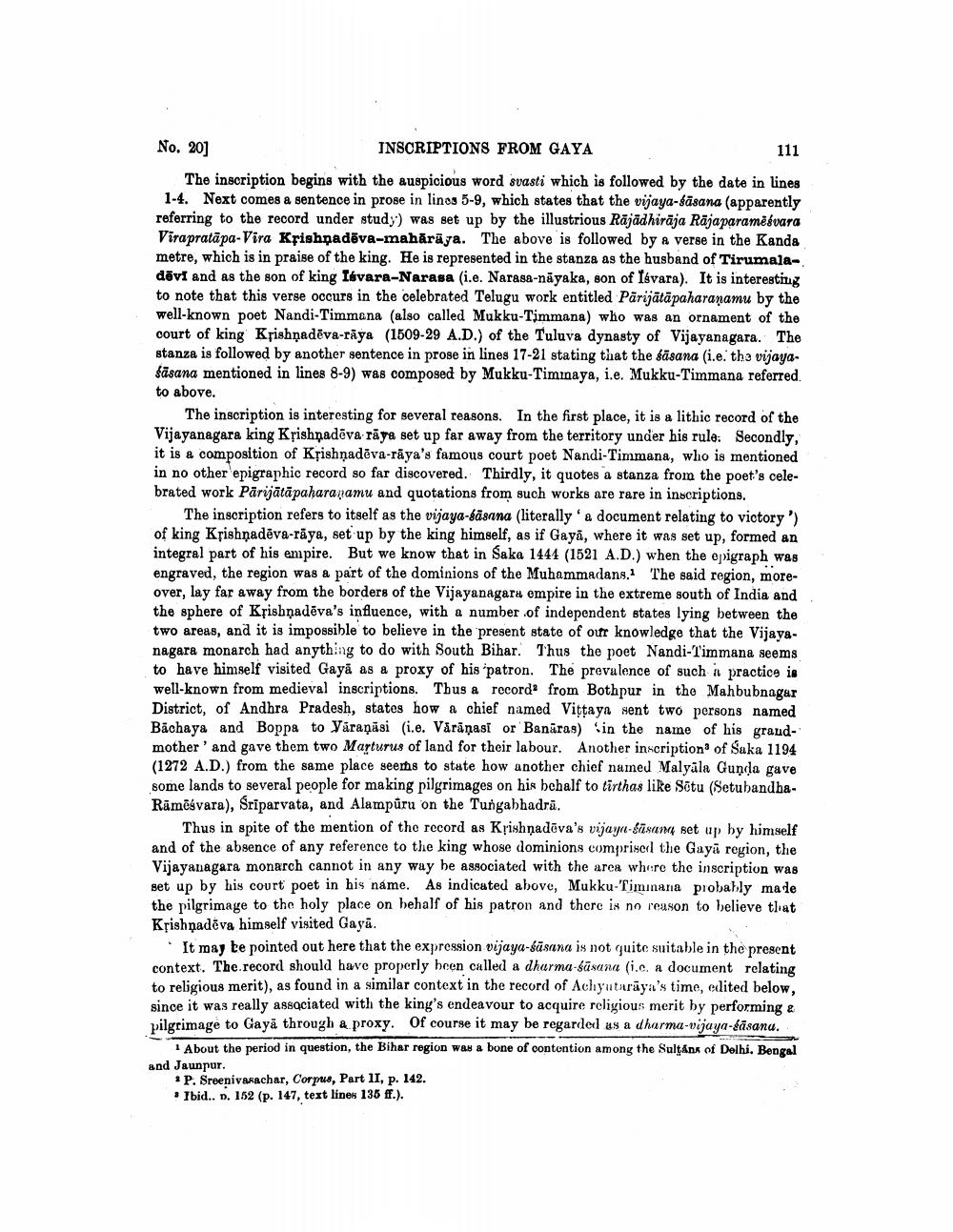________________
111
No. 20]
INSCRIPTIONS FROM GAYA
The inscription begins with the auspicious word svasti which is followed by the date in lines 1-4. Next comes a sentence in prose in lines 5-9, which states that the vijaya-sasana (apparently referring to the record under study) was set up by the illustrious Rajadhiraja Räjaparamèsvara Virapratapa-Vira Krishnadeva-maharaya. The above is followed by a verse in the Kanda metre, which is in praise of the king. He is represented in the stanza as the husband of Tirumaladevi and as the son of king Isvara-Narasa (i.e. Narasa-nayaka, son of Iévara). It is interesting to note that this verse occurs in the celebrated Telugu work entitled Pärijätäpaharanamu by the well-known poet Nandi-Timmana (also called Mukku-Timmana) who was an ornament of the court of king Krishnadeva-raya (1509-29 A.D.) of the Tuluva dynasty of Vijayanagara. The stanza is followed by another sentence in prose in lines 17-21 stating that the sasana (i.e. the vijayaśāsana mentioned in lines 8-9) was composed by Mukku-Timmaya, i.e. Mukku-Timmana referred. to above.
The inscription is interesting for several reasons. In the first place, it is a lithic record of the Vijayanagara king Krishnadeva raya set up far away from the territory under his rule. Secondly, it is a composition of Krishnadeva-raya's famous court poet Nandi-Timmana, who is mentioned in no other epigraphic record so far discovered. Thirdly, it quotes a stanza from the poet's celebrated work Pārijātāpaharanamu and quotations from such works are rare in inscriptions.
The inscription refers to itself as the vijaya-sasana (literally a document relating to victory') of king Krishnadeva-raya, set up by the king himself, as if Gaya, where it was set up, formed an integral part of his empire. But we know that in Saka 1444 (1521 A.D.) when the epigraph was engraved, the region was a part of the dominions of the Muhammadans. The said region, moreover, lay far away from the borders of the Vijayanagara empire in the extreme south of India and the sphere of Krishnadeva's influence, with a number of independent states lying between the two areas, and it is impossible to believe in the present state of our knowledge that the Vijayanagara monarch had anything to do with South Bihar. Thus the poet Nandi-Timmana seems to have himself visited Gaya as a proxy of his 'patron. The prevalence of such a practice is well-known from medieval inscriptions. Thus a records from Bothpur in the Mahbubnagar District, of Andhra Pradesh, states how a chief named Viṭṭaya sent two persons named Bachaya and Boppa to Varanasi (i.e. Varanasi or Banaras) in the name of his grandmother' and gave them two Marturus of land for their labour. Another inscription of Saka 1194 (1272 A.D.) from the same place seems to state how another chief named Malyala Gunda gave some lands to several people for making pilgrimages on his behalf to tirthas like Satu (SetubandhaRāmēsvara), Sriparvata, and Alampuru on the Tungabhadra.
Thus in spite of the mention of the record as Krishnadeva's vijaya-tasana set up by himself and of the absence of any reference to the king whose dominions comprised the Gaya region, the Vijayanagara monarch cannot in any way be associated with the area where the inscription was set up by his court poet in his name. As indicated above, Mukku-Timmana probably made the pilgrimage to the holy place on behalf of his patron and there is no reason to believe that Krishnadeva himself visited Gaya.
It may be pointed out here that the expression vijaya-sasana is not quite suitable in the present context. The record should have properly been called a dharma-sasana (i.c. a document relating to religious merit), as found in a similar context in the record of Achyutaraya's time, edited below, since it was really associated with the king's endeavour to acquire religious merit by performing & pilgrimage to Gaya through a proxy. Of course it may be regarded as a dharma-vijaya-gāsana.
About the period in question, the Bihar region was a bone of contention among the Sultans of Delhi. Bengal and Jaunpur.
P. Sreenivasachar, Corpus, Part II, p. 142. Ibid.. n. 152 (p. 147, text lines 135 ff.).




